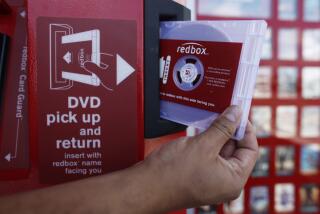Roku box developer has a sixth sense about video
As the last century waned, scarcely a day passed without someone showing up in our newsroom offering a demonstration of a new dot-com service or consumer device. ECommerce sites for T-shirts and sandals, search sites paying jackpots to lucky users, you name it.
One day a team from a company called ReplayTV wheeled in a television set wired to a box with a hard drive inside. They hooked it up to our cable jack to show how we could use it to pause, rewind and fast-forward live TV.
I still remember that day because it was the only time I ever left one of those pitch meetings thinking, âThat will change my life, and I must have it.â Today such devices, known as digital video recorders, are commonplace â a survey last year estimated that 36% of all U.S. homes have at least one, many provided by their cable or satellite company.
The man who conceived the ReplayTV device was Anthony Wood. Now 44, he is also the man behind the Roku box. This device, the size of a couple of decks of cards, is one of several allowing Netflix subscribers to stream movies and television episodes directly to their TV sets via a home Internet connection, without waiting for a DVD to arrive in the mail.
That makes Wood possibly the only man alive to have placed two digital inventions in my house â a historical footnote, to be sure (if that), but one that hints at his remarkable instinct for the consumer market.
A serial entrepreneur, Wood has experienced almost everything that can happen in the high-tech business since he founded his first company in high school in Houston to sell software: He made almost $1 million with one company, got turned down by dozens of venture firms with another, then landed backing from a big firm and got shouldered into the background by his investors. Heâs been bought out and spun off, and heâs still here to tell the tale.
Privately held Roku Inc. is Woodâs sixth startup company (the name means âsixâ in Japanese) and its working environment is right out of the form book: offices in a Silicon Valley industrial strip, no receptionist in sight, packing materials stacked here and there, whiteboards in the conference rooms covered with inscrutable flowcharts. Wood met me at Rokuâs Saratoga headquarters not long ago dressed in baggy jeans held up with suspenders.
Wood started ReplayTV in 1997 after leaving Macromedia Inc., to which he had sold a precursor to the leading Web authoring program Dreamweaver. (Macromedia later was acquired by Adobe Systems Inc.)
âIâd had the idea for the DVR for a long time,â he told me. âBut Iâd look at the prices for hard drives and at compression technology and it was not practical.â Initially, no venture firms would back his proposal for a consumer TV player, so he funded ReplayTV from his own pocket and money from private angel investors, and started hiring engineers to make his idea a reality.
ReplayTV found itself in competition with TiVo, which was employing a different business plan to market a similar device. Where ReadyTV charged full price for its box â as much as $1,000 in the early days â TiVo sold its unit for less upfront but charged a monthly or annual subscription fee to make up the difference.
Both companies cut deals with entertainment companies, but TiVo was more âindustry-friendly,â as Wood puts it. For example, ReplayTV had a 30-second skip-ahead function, which drove broadcasters nuts because it allowed users to avoid seeing commercials; with your TiVo box you could only fast-forward through the ads, not miss them completely.
ReplayTV bested TiVo for video best in show honors at the Consumer Electronics Show in 1999. But TiVo beat ReplayTV to the IPO stage, raising $88 million that same year. By the time ReplayTV was ready to go public, the market had crashed and the IPO window shut tight. ReplayTV was eventually acquired by DirecTV for its patents. TiVo still exists, but it has lost money in nine of the last 10 years.
Wood launched Roku in 2002 to market home digital devices. Its first products included a unit to display photos and art images on HDTVs, which were still novel, and Soundbridge, which allowed you to stream your digital music files or Internet radio stations to speakers around your house.
Meanwhile, Netflix was trying to figure out how to sell video via the Internet. In 2007 it brought Wood into the fold as vice president of Internet TV. He built the team that developed what became the Roku box as well as applications allowing PC users to stream Netflix movies onto their computers. Differences of approach soon surfaced â for example, Wood wanted to offer streaming services to video distributors such as Amazon, which he says made Netflix uneasy. Netflix didnât see itself as a hardware company, so it spun Woodâs engineering team back out to Roku, retaining the rights to license the technology to others.
Roku duly signed up Amazon â for a fee you can rent or buy movies and TV episodes from Amazon to view via the box â along with other partners such as Major League Baseball. Rokuâs Channel Store also offers 75 channels developed by outsiders, much as Appleâs App store offers third-party apps for the iPhone and iPad.
Sales have soared as consumers get used to the idea of streaming TV and to the technology. This year Wood expects revenue to reach $50 million to $60 million, up from $33 million last year and $17 million the year before that.
Yet Roku is the kind of company that may never be out of the woods (so to speak). Netflix has licensed its streaming technology to makers of Blu-ray DVD players and for game players such as Microsoftâs Xbox and Nintendo Co.âs Wii, all of which compete with Roku.
The device Wood says he worries about the most, however, is Apple TV, introduced by Steve Jobs last month. That device also affords access to Netflix, as well as to movie and TV episode rentals. On the other hand, it sells for $99; Rokuâs two cheapest units offer similar if not superior services for $59 and $79. On the horizon is Google TV, which will roll out later this year but will be available, at first, only in a $300 box.
Wood says heâs counting on video distribution continuing to move away from cable transmission and the DVD and toward Internet delivery. âThat trend is what will make Roku successful,â he told me. âWe think the one box to rule them all will be the Roku box.â
Considering that video is the most rapidly evolving entertainment market, thatâs an audacious prediction. Still, given Woodâs track record, whatever he thinks about the future, Iâm willing to listen.
Michael Hiltzikâs column appears Sundays and Wednesdays. Reach him at [email protected], read past columns at latimes.com/hiltzik, check out facebook.com/hiltzik, and follow @latimeshiltzik on Twitter.







